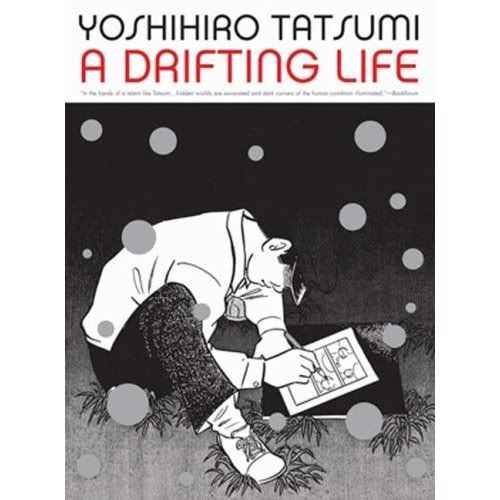So back in early December I still had a couple of weeks left in school but, having finally finished Buddha, I had nothing left to read. I revisited the school library and picked this book out of the upstairs comic section since I’d heard a number of good things about it. I was initially intimated by the length of it (I told myself that one 800 page book wasn’t nearly as bad as eight 300 page volumes for Buddha, didn't make it seem any smaller) but I’m really glad I read it, not only for the story but for the insight in the history of manga.
A Drifting Life by Yoshiro Tatsumi
Summary: An autobiographical story with the names changed, young Hiroshi loves to make comics and is coming of age in a boom time for manga. Although most of the manga he draws are short stories or quick gag comics he has a deep love for longer stories and incorporating more cinematic forms of story telling. This isn’t what the publishers are looking for however so he is constantly trying to balance out drawing what pays and drawing this dream of his.
The Good: Lots of pages but it makes for surprisingly quick reading. The story flows smoothly and it’s separated into many chapters so it’s easy to pick it up, read a little, and then go do something else. Some people won’t find the subject material (young boy trying to make it in the publishing world in the 1950s) interesting but as a fan of slice of life I found it gripping. I also found the bits of the story that dealt with the publishers (rejecting this story on these grounds, troubles with the manga renting stores) fascinating, especially after sitting back and realizing how far manga has come from the 1940s and 50s. Most people will be able to figure out quickly if this is interesting to them or not but I really encourage manga fans to try it, it certainly won’t hurt if more know more about manga itself.
The Bad: The story ends in a rather odd place and I still don't understand the reasoning for it. I expected the story to end when Hiroshi came to some sort of conclusion about his work but it instead ends in the middle of a protest in the 1960s that doesn’t have more than a slight thematic connection to the work (maybe Tatsumi realized the story was getting too long and decided to end it there?). Odder still is how there is then an epilogue in the mid-90s dealing with the anniversary of Tezuka’s death and we still don't see if Hiroshi is happy with his work or not. After seeing Hirohi’s life so meticulously recorded from age ten up to his mid-twenties it just felt abrupt, and I really did want to see him find happiness and success in his work, no matter how long the story was.
The Art: The art is rather simplistic, odd considering it’s an autobiographical work and I’m used to see more a more detailed style there, but the art does it’s job and supports the words in the story (even if the simplistic style made it hard to tell many of the characters apart). I liked how the various works Hiroshi created where shown in the story (usually just their covers), it was interesting to see how his work (and really almost every other manga-ka’s work in the story) was very similar to his idol's, Osama Tezuka. I thought that spoke volumes about the history of manga, how the medium has changed and grown so much more diverse; today most manga-ka have a distinctive style but it looks like that happened when the medium moved away from solely doing gag comics and short stories (I’d love to see if anyone has done any research on the subject or if my theory is completely off). And finally, as a warning, the book is flipped* and at 800 pages I found it a little hard to hold.
An excellent book that probably won't interest the casual manga fan but I would still recommend anyway. And my library still has a few more series that I haven't gotten to yet, think I might try Akira next...
*reading this right after reading the also flipped Buddha made me feel as if I was committing a crime against manga….
